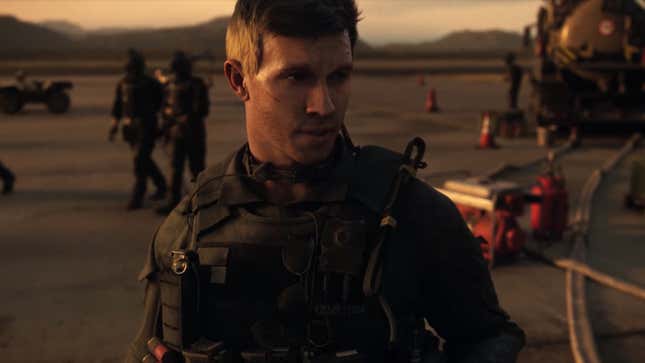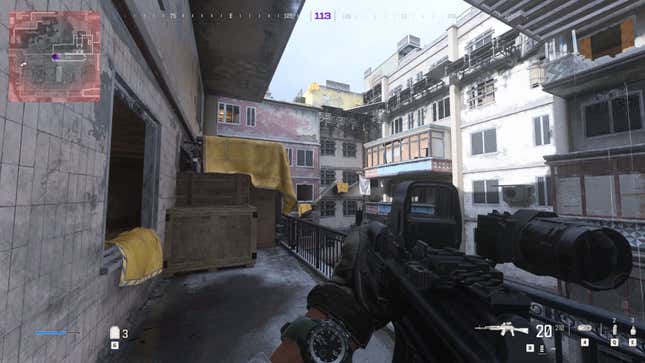Sure, Modern Warfare III, the latest Call of Duty release featuring a brand new single-player story, failed to shake up the format of traditional Call of Duty campaigns. But as I said in our review of the single-player offering, MWIII’s more open-ended levels show some interesting potential, and hint at a more freeform style of Call of Duty which, with better implementation, could potentially combine the best elements of the series current offerings: campaign, Warzone, and, most importantly, the PvPvE extraction mode, DMZ.
Read More: The Call Of Duty: Modern Warfare Franchise Explained
Pre-order Modern Warfare III: Amazon | Best Buy | GameStop
Advertisement
These different modes are all mostly siloed in their respective camps and launchers, but MWIII represents a unique attempt to fuse the more open-ended gaming experiences of Warzone or DMZ into a single-player campaign. It struggles to deliver on this premise, but the notion of a unique Call of Duty experience where players must use their intuition and carefully plan their approach rather than following clearly defined, linear paths is a promising one, and one which deserves a better single-player, co-op implementation. DMZ provides a pretty solid proof of concept for that.
Advertisement
Call of Duty deserves more experiences like DMZ
DMZ is a PvPvE extraction shooter mode within Warzone where you can die and lose all of your treasured gear. Though it’s not the genesis of this kind of mode (Escape From Tarkov arguably lays claim to that), it does streamline what is otherwise a very punishing experience.
Advertisement
Read More: The Evolution Of Games Like Fortnite And Warzone Is Already Here
In DMZ, you don’t have to keep track of bullets, survival-based health stats, or other minutiae; and you have access to certain types of renewable gear like smoke grenades or throwing knives. So starting from scratch after death isn’t such a dramatic, punishing setback as it is in other games. But a perfectly kitted-out sniper rifle is yours to find, enjoy, and protect by surviving each deployment, lest you die and lose it forever. “Winning” isn’t a matter of just following the story beats or even just completing key objectives. In DMZ (as well as Warzone to varying degrees), players need to rely on preparation, discovering loot, and real-time decisions. It’s a balancing act that single-player CoD doesn’t usually offer with its more cinematic, on-rails approach.
Advertisement

While Call of Duty campaigns aim to deliver the experience of critical, life or death moments among the most lethal creations of humanity, the safety of a dominating, scripted narrative always prevents that from actually being the case in the game. If you fail to accomplish your mission, you just go back to a checkpoint with all of your stuff, ready to try again—and try again in almost the exact same way as you did last time, following whatever path that specific level has laid out for you.
Advertisement
Read More: This Warzone TikTok Shows Why DMZ Is So Amazing
DMZ, as well as Warzone, shatters that security of narrative, but still offers explosive gameplay that can mirror the same scenarios you’d play in a campaign. Instead of playing the “sniper level” or the “stealth level” as ordained by a rigid campaign structure, however, these scenarios emerge more dynamically.
Advertisement
Interesting narratives and non-linear gameplay aren’t mutually exclusive
The popularity of DMZ and Warzone prove that there’s an appetite for game modes where the rules are written as you go along, ones that can shift and change dynamically depending on what gear you find in an open world, ones where you need to defend your loot. But the gap between Warzone and CoD campaigns hasn’t done the series any favors—and it’s one of the many reasons MWIII’s campaign hits so strangely. It’s no longer enough to simply play each single-player game to keep up on which characters are alive or dead and why. If you got to Modern Warfare III’s campaign and wondered how the hell Graves was still alive, then you must’ve missed season five of Warzone, as his arrival as a playable operator was also a confirmation that he survived the events of Modern Warfare II.
Advertisement
Read More: Modern Warfare III’s Campaign Mostly Sucks
Expecting folks to keep up with narrative beats that unfurl mostly through the addition of in-game cosmetics in the shop isn’t an ideal way to tell a story. But DMZ has shown potential for environmental storytelling that could be adapted to tell stories in the moment of the game.
Advertisement
In DMZ, the main map of Al Mazrah has seen some interesting changes in the last year. From a mysterious, crashed airplane that’s guarded by overwhelming lethal forces, to portions of the city getting hit with sandstorms, AI changing their behaviors based on developments in the story, to casting the entire map in darkness most recently, DMZ has shown that an open world environment doesn’t just need to be a rigid, unchanging thing that you play in over and over again into eternity.
At any point along the way, a single death can reset all your DMZ progress. That may sound hard or unfair, but it also is exactly like intense situations the characters face in a single-player CoD campaign—like Ghost sneaking through the prison complex or Soap needing to survive being hunted down by Shadow Company in MWII. Yet those examples always come with the comfort of falling back to a checkpoint if you fail.
Advertisement
DMZ often produces similar, moment-by-moment scenarios you’d find in a campaign, except you’re actually the main character making the decisions, not just a participatory observer. You’re not guaranteed a comfortable supply of ammo and the liberty of infinite respawns and checkpoint reloads. The high-stakes pressure usually reserved for the cutscenes, rendering a player a passive observer, are the actual gameplay moments in DMZ.

Advertisement
DMZ’s maps are often places where interesting things happen or are happening, be those scripted narrative events or the emergent possibilities of PvPvE. You have to survive the map’s depths and challenges to accomplish objectives and get out alive. MWIII’s open areas (of which there are six of them out of 14 total levels) don’t have the same offerings. As fixtures of a single-player game, they also won’t see updates, but they don’t have interesting things going on in them to begin with.
An exception might be the open combat mission “Highrise,” where after a freeform battle through an apartment complex, you’re joined by Captain Price for a rooftop shootout. During the mission, you have a choice of which weapons you’d like to use, and what angles you wish to enter various rooms from, and a sense that you can come back with better equipment for new options. It’s not a perfect campaign mission, but at least there’s an amount of freedom combined with a sense that narrative things are happening here. Price’s role in the level shows CoD’s popular characters and narrative beats can coexist within this open framework.
Advertisement
Since its launch, DMZ has existed in “beta” status. With the full launch of MWIII’s multiplayer and PvE Zombies mode nearly here (out November 10), it remains to be seen where DMZ fits in. Still, the mode has managed to showcase how to free up CoD’s base formula of guns and tactical equipment, and even utilized it in a non-traditional campaign level. MWIII’s campaign provides neat “what if” food for thought with Call of Duty—hopefully Activision continues to experiment with mix-and-matching elements from their myriad game modes to create new and interesting ways to play.
Pre-order Modern Warfare III: Amazon | Best Buy | GameStop
.






